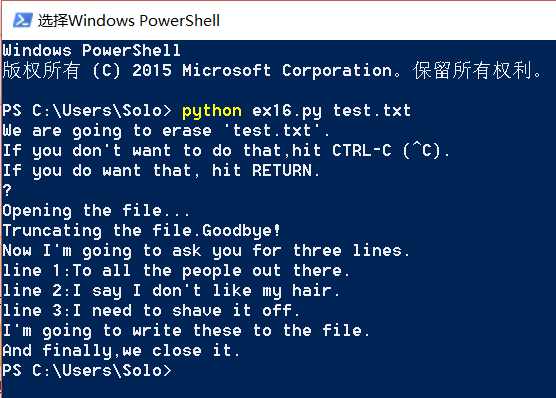《笨办法学Python》 第16课手记
《笨办法学Python》 第16课手记
本节课在上一节的基础之上加入了对文件的写操作,代码较长,请注意不要有遗漏。
原代码如下:
from sys import argv
script, filename = argv
print "We are going to erase %r." % filename
print "If you don't want to do that,hit CTRL-C (^C)."
print "If you do want that, hit RETURN."
raw_input("?")
print "Opening the file..."
target = open(filename, 'w')
print "Truncating the file.Goodbye!"
target.truncate()
print "Now I'm going to ask you for three lines."
line1 = raw_input("line 1:")
line2 = raw_input("line 2:")
line3 = raw_input("line 3:")
print "I'm going to write these to the file."
target.write(line1)
target.write("\n")
target.write(line2)
target.write("\n")
target.write(line3)
target.write("\n")
print "And finally,we close it."
target.close()结果如下:
请注意,我在出现前三行字符时,按的是回车键,按ctrl+c可以撤销操作。
还是作者强调的,在打开一个文件,并进行完操作之后,记得关闭它们(“使用close()”)。
至于target = open(filename, ‘w’)里面的w,我在上一节已经讲过了,不再赘述。
本节课涉及的知识:
变量名.函数,是使用函数对变量进行操作的方法,已经强调过,请牢记。
至于write函数,括号里给出要写入的内容,字符串需要加“”,变量则不用,因此双引号的作用是将变量和字符串区分开来。
请仔细阅读常见问题解答,并尝试记住他们。







